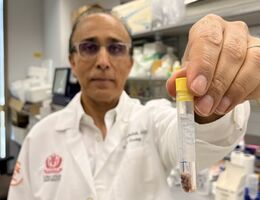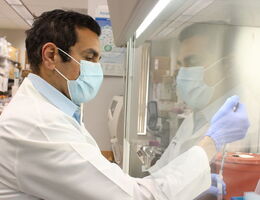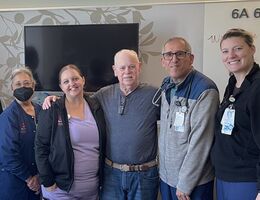
Hematological malignancies (blood cancers) are caused by uncontrolled growth of abnormal blood cells, while non-cancerous blood disorders, genetic or metabolic disorders are caused by variations in DNA that affect healthy blood function.
If you’re fighting one of these conditions, your doctor may suggest Transplant and Cellular Therapy (TCT). Our TCT division offers treatments designed to replace, correct, and/or destroy unhealthy blood cells, supporting healthy cell regeneration. While these treatments are highly complex and require careful evaluation to see if they’re right for you, they have proven effective against a number of conditions.
Our Division of Transplant and Cellular Therapy/Hematological Malignancies is the only treatment program in our region to offer specialized TCT therapies for treating hematological malignancies (blood cancers), non-cancerous blood disorders, and other rare genetic and immune conditions.
Why Choose Us
We’re dedicated to treating the whole person — that means your physical, mental, and spiritual needs. Our team is here to support you every step of the way.
- Experts in pediatric and adult TCT therapy: We’ve successfully treated children and adults diagnosed with cancer, non-cancerous blood disorders, and genetic/metabolic disorders.
- Research-backed treatments: Our team combines clinical services with research to provide you with top-notch treatments and lead the development of new cell therapies.
- Collaborative approach to care: Our diverse team of specialists work together to provide you with the highest level of care.
- Internationally recognized accreditation: Our program is accredited by the Foundation for the Accreditation of Cellular Therapy (FACT). We are the first and only facility in our region to earn the international gold standard for transplant and cell therapy for both adults and children.
Conditions We Treat
Hematological Malignancies (Blood Cancers)
- Acute myeloid leukemia (AML)
- Acute lymphoblastic leukemia (ALL)
- Chronic myeloid leukemia (CML)
- Chronic lymphocytic leukemia (CLL)
- Hodgkin lymphoma
- Non-Hodgkin lymphoma
- Multiple myeloma
Solid Tumors Requiring Treatment with Stem Cell Transplant or CAR-T cell therapy
- Neuroblastoma
- Brain tumors
- Synovial sarcomas
Non-Cancerous Blood Disorders
- Aplastic anemia
- Sickle cell disease
- Thalassemia
Genetic or Metabolic Disorders
- Hurler syndrome
- Wiskott-Aldrich syndrome (an immune system disorder)
- Severe combined immunodeficiency (SCID)
- Alpha mannosidosis
- Bone marrow failure syndromes
- Congenital amegakaryocytic thrombocytopenia (CAMT)
- Adrenal leukodystrophy
Services We Provide
Bone Marrow Transplant
A bone marrow transplant (BMT), also known as a stem cell transplant, is a procedure that involves replacing diseased or damaged bone marrow — the soft tissue inside bones where blood cells are produced — with healthy stem cells that can help regenerate your bone marrow and restore normal blood cell production. This procedure is effective at treating leukemias, lymphomas, and multiple myeloma, as well as various non-cancerous blood disorders and genetic or metabolic disorders.
Bone Marrow Transplants Explained
The first step of a bone marrow transplant is to collect healthy stem cells to replace the damaged ones. Healthy stem cells can either come from your own body (autologous transplant) or from a healthy donor match (allogeneic transplant) such as a sibling or unrelated individual. Next, you will undergo chemotherapy/radiation treatment to kill cancer cells and prepare your body for healthy cells. The collected stem cells are then infused into your body after chemotherapy or radiation to help regenerate healthy cells.
You should anticipate a hospitalization lasting 6-8 weeks to receive all the medicines to prepare your body for the stem cell transfusion and to allow your immune system to recover enough to safely leave the hospital after stem cell infusion. The stem cell infusion itself takes several hours. After the stem cell infusion, healthy cells will start to regenerate (engraftment), which can take weeks. You will need to stay in the hospital or visit an outpatient clinic daily during this critical phase of your treatment.
Am I a Candidate for Treatment?
You might be a candidate for a bone marrow transplant if:
- You are currently in remission, but at high risk of relapse
- Your condition is resistant to other treatments
- You are in the early stages of disease and may benefit from a transplant as a potential cure
Bone marrow transplants can be lifesaving, but it’s important to know the risks. The process involves several stages, including preparation with intensive treatments (chemotherapy or radiation), the transplant itself, and a recovery phase where your immune system is rebuilt. Success depends on multiple factors such as your overall health, the quality of the donor match, and careful management of potential complications.
CAR-T Cell Therapy
Chimeric antigen receptor CAR-T cell therapy harnesses the power of your own immune system to target and destroy cancer cells. It’s used to treat certain types of blood cancers, including acute lymphoblastic leukemia (ALL), non-Hodgkin lymphoma (NHL), and chronic lymphoblastic leukemia (CLL). CAR T-cell therapy is not yet widely available for all cancer types but is being studied for use in multiple myeloma and other cancers.
CAR-T cell therapy Explained
CAR T-cell therapy involves modifying your T-cells, a type of white blood cell that plays a crucial role in your immune system’s ability to fight infections and cancer. The T-cells are first collected from your bloodstream, genetically modified in the lab to help fight cancer cells, multiplied to create millions of these cells, and then reinfused back into your bloodstream via an IV to kill cancer cells directly.
Here’s a simplified, step-by-step breakdown of the process:
- T-cell collection: T-cells are collected from your bloodstream via a several hour-long blood apheresis, where your blood is drawn, the T-cells are extracted, and the remaining blood is returned to your body.
- Genetic modification: Your T-cells are then genetically modified to contain receptors that recognize cancer cells and destroy them. These gene-modified T-cells are called chimeric antigen receptor T-cells (CAR-T cell therapy-cells).
- Cell culture expansion: Your modified T-cells are multiplied in the lab to create millions of these cancer-fighting T-cells. This process can take a few weeks, depending on the specific therapy used.
- Infusion and targeting cancer cells: The CAR-T cell therapy-cells are infused back into your bloodstream to target and kill cancer cells.
Receiving CAR-T cell therapy involves several stages, including evaluation and preparing you for treatment. You can expect a hospital stay of 6-8 weeks, during which time you will receive the infusion and be monitored for side effects. The total length of your hospital stay will depend on your specific situation.
Am I a Candidate for Treatment?
You might be a candidate for CAR-T cell therapy if:
- You are diagnosed with non-Hodgkin lymphoma, including various subtypes like diffuse large B-cell lymphoma (DLBCL).
- You are diagnosed with acute lymphocytic leukemia (ALL), especially in cases where the disease has not responded to other treatments.
- If you're the parent of a child or young adult diagnosed with B-cell acute lymphoblastic leukemia (B-ALL), CAR-T cell therapy may be a promising treatment option.
Gene Therapy
Gene therapy is an innovative FDA-approved treatment that works by correcting the body’s ability to make healthy red blood cells. The therapy is a curative treatment for diseases that cause unhealthy red blood cells, such as sickle cell disease or transfusion-dependent thalassemia. The stem cells are modified to either include genes for making healthy red blood cells or to increase the body’s ability to make a type of healthy red blood cell called fetal hemoglobin.
Gene therapy has several potential benefits, including reducing the need for blood transfusions and improving your overall quality of life. Gene therapy may also provide a long-term cure which allows your stem cells to make healthy red cells for life.
Gene Therapy Explained
Your care team will collect a sample of your blood to identify and edit/replace the gene responsible for the disorder. Once the genetic change is made, the modified cells are returned to your body via infusion or injection into your bloodstream to start creating healthy blood cells.
Here’s a simplified, step-by-step breakdown of the process:
- Cell collection: First, we collect blood stem cells from your blood. These stem cells contain genes that can produce unhealthy blood cells when there are disease-causing variations in the DNA.
- Gene editing or insertion: In a laboratory setting, a gene responsible for healthy production of red blood cells is introduced into the stem cells either using a lentiviral vector or CRISPR/Cas9. These methods are used to make a genetic edit that allows for increased fetal hemoglobin and therefore decreased unhealthy red blood cells.
- Cell infusion: The modified stem cells are reintroduced to your bloodstream via infusion, where they can travel to the bone marrow and start producing healthy blood cells.
Receiving gene therapy involves several stages, such as evaluation and preparing you for treatment. You can expect a hospital stay of 4-6 weeks, during which time you will receive the infusion and be monitored for side effects. The total length of your hospital stay will depend on your specific situation.
Am I a Candidate for Treatment?
If you’re fighting an inherited blood disorder such as sickle cell disease or thalassemia, gene therapy may be the ideal treatment for you. However, while early results of using gene therapy for blood disorders are promising, it’s still an evolving treatment. Your doctor will consider factors such as your age, overall health, and the severity of your condition when determining if this treatment is right for you.
Take the Next Step
We're here to support and guide you every step of the way. Your primary care physician or the emergency department may refer you to the Loma Linda University Cancer Center. If you'd like to receive treatment at our cancer center, ask your doctor for a referral.
Referring providers can contact us at 909-558-9602 or [email protected]
Featured Articles

The role of genetic testing in cancer immunotherapy

Loma Linda University Health's first CAR-T cell therapy patient: Ruben Andrade's journey to recovery

Loma Linda University Health’s cell therapy division receives accreditation











